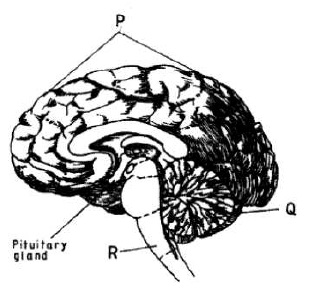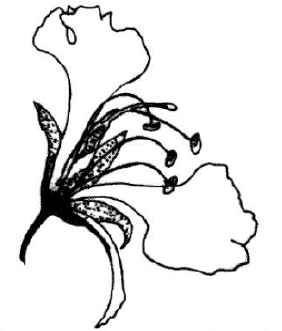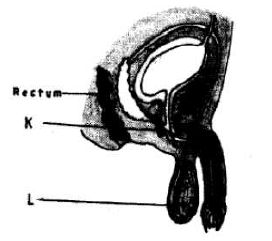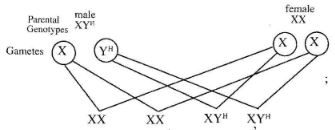SECTION A (40 marks)
Answer all the questions in this section in the spaces provided.
- The set-up below illustrates a procedure that was carried out in the laboratory with a leaf plucked from a green plant that had been growing in sunlight.
- What was the purpose of the above procedure? (1 mark)
- Give a reason for carrying out steps A, B and C in this procedure. (3 marks)
- Name the reagent use at the step labelled D. (1 mark)
- State the expected result on the leaf after adding the reagent named in (iii) above. (1 mark)
- In humans, hairy ears is controlled by a gene on the Y chromosome.
- Using letter YH to represent the chromosome carrying the gene for hairy ears, work out a cross between a hairy eared man and his wife.
- What is the probability of the girls having hairy ears? (1 mark)
- Give a reason for your answer in b(i) above. (1 mark)
- Name two disorders that are determined by sex-linked genes. (2 marks)
- Explain how comparative embryology is an evidence for organic evolution. (2 marks)
- Using letter YH to represent the chromosome carrying the gene for hairy ears, work out a cross between a hairy eared man and his wife.
- Name the causative agents for the following respiratory diseases. (2 marks)
- Whooping cough
- Pneumonia
- Describe how oxygen in the alveolus reaches the red blood cells. (4 marks)
- How are the pneumatophores adapted to their function? (2 marks)
- Name the causative agents for the following respiratory diseases. (2 marks)
- The diagram below represents a human brain.
- Name the structures labeled P and R. (2 marks)
- State two functions of the part labeled Q. (2 marks)
- Name two reproductive hormones secreted by the pituitary gland in women. (2 marks)
- State one function of each of the hormones named in (b)(i) above. (2 marks)
- The diagram below represents a human brain.
- The diagram below represents a flower.
- On the diagram, name two structures where meiosis occurs. (2 marks)
- How is the flower adapted to self-pollination? (2 marks)
- How is the flower adapted to prevent self-pollination? (2 marks)
- The diagram below represents a human reproductive organ.
- Explain two adaptations of the structure labeled L to its functions. (2 marks)
- Explain the role of the gland labeled K. (2 marks)
SECTION B (40 marks)
Answer question 6 (compulsory) and either question 7 or 8 in the spaces provided after question 8.
- The diagram below represents a flower.
- An experiment was carried out to investigate the population of a certain micro-organism. Two petri-dishes were used. Into the petri-dish labeled M, 60cm3 of a culture medium was placed while 30 cm3 of the same culture medium was placed in petri-dish labeled N. Equal numbers of the micro-organisms were introduced in both petri-dishes. The set ups were incubated at 350C. The number of micro-organisms in each petri-dish was determined at irregular intervals for a period of 60 hours. The results were as shown in the table below.
- On the same axes, draw the graphs of relative number of micro-organisms against time on the grid provided. (7 marks)
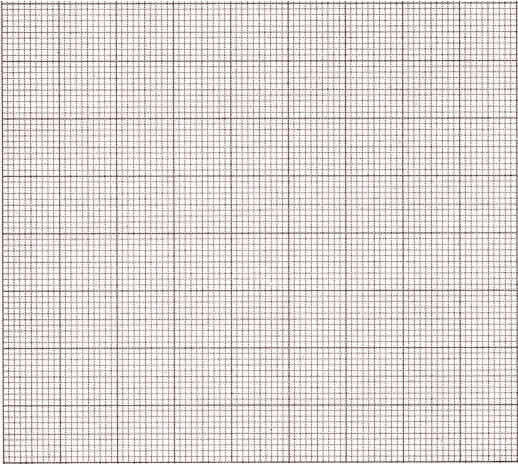
- After how many hours was the difference between the two populations greatest? (1 mark)
- Work out the difference between the two populations at 50 hours. (2 marks)
- With a reason, state the effect on the population of micro-organisms in petri-dish M if the temperature was raised to 600C after 20 hours. (2 marks)
- Account for the shape of the curve for population in petri-dish N between 46 hours and 59 hours. (3 marks)
- On the same axes, draw the graphs of relative number of micro-organisms against time on the grid provided. (7 marks)
- Explain how the osmotic pressure in human blood is maintained at normal level. (5 marks)
- An experiment was carried out to investigate the population of a certain micro-organism. Two petri-dishes were used. Into the petri-dish labeled M, 60cm3 of a culture medium was placed while 30 cm3 of the same culture medium was placed in petri-dish labeled N. Equal numbers of the micro-organisms were introduced in both petri-dishes. The set ups were incubated at 350C. The number of micro-organisms in each petri-dish was determined at irregular intervals for a period of 60 hours. The results were as shown in the table below.
- Explain how structural feature sin terrestrial plants affect their rate of transpiration. (13 marks)
- Explain how the human skin brings about cooling the body on a hot day. (7 marks)
- Describe the exoskeleton and its function in insects. (13 marks)
- Describe how accommodation in the human eye is brought about when focusing on a near object. (7 marks)
MARKING SCHEME
-
- Testing a leaf for the presence of starch;
- A- kill the leaf/break down cells/stop enzymatic activity;
B - Removal of chlorophyll;
C - Soften leaf/makes leaf less brittle; - Iodine solution;
- Areas where starch is present stain blue/blue black;
-
-
-
- Probability of girls having hairy ears is zero 'O';
- The gene for hairy ears is on the Y chromosomes which girls do not inherit from their father;
- Haemophilia; Colour blindness;
- Vertebrate embryos have similar morphological features; which suggest a common ancestry;
-
-
-
- Bordetella pertussis;
- Streptococcus pneumoniae;
- Micoplasma pneumoniae;
- Inhaled oxygen dissolves in moisture in the alveolus; since the oxygen concentration in blood is lower; than in the alveolus, oxygen diffuses; through the alveolus epithelium, the capillary wall into the plasma; and finally into the red blood cells.
- Pneumatophores - grow into the air above mud/water; their lenticel for gaseous exchange;
-
-
-
- P - is cerebral hemisphere/cerebrum;
R- medulla oblongata; - Muscular co-ordination; maintaining body posture; manual /motar dexterity; (first two)
- P - is cerebral hemisphere/cerebrum;
-
- Follicle stimulation hormone; luteinizing hormone; oxytocin, prolactin;
- FSH - stimulates secretion of oestrogen; stimulates development of the Graafian follicle;
LH - Brings about ovulation; causes development of corpus luteum;
Oxytocin - causes contraction of uterus; causes expulsion of milk from mammary glands;
Prolactin - stimulates milk production/secretion;
-
-
-
- Anthers; Ovary;
- Anthers are below the stigma to minimise self pollination;
- petals are large/conspicuous, for insects to land on/ to attract insects encouraging cross pollination;
presence of interstitial cells that secrete androgens.
-
- L is hanging outside the body to ensure optimal temperature for sperm production; it has many, long and coiled seminiferous tubules to increase the surface area for production/storage of sperms;
- K produces an alkaline fluid that neutralizes acid in the vagina; this fluid contain nutrients for the sperms; and also activates sperms;
-
-
-
- See graph.
- 42 hours;
- Graph M at 50 hrs is 1220 - 20.
Graph N at 50 hrs is 540 + 20
1220 - 540 = 680 + 4; - Population growth stops;
High temperatures kill the microorganisms/denature enzymes; (2 marks) - 46 hours to 59 hours death rate of the microorganisms is higher than their population growth rate, due to exhaustion of nutrients; and accumulation of toxic wastes;
- When the osmotic pressure of the blood increases beyond the normal level the hypothalamus detects this and stimulates the pituitary gland; to secrete more ADH; hormone which make kidney tubules more permeable to water, and more water is re-absorbed into the blood; reducing the osmotic pressure to the normal level.; (accept the reverse description)
-
-
- Plants in arid, semi-arid and desert habitats have leaves covered with thick/waxy cuticles; that are waterproof/impermeable to water; allowing for reduced rate of transpiration; Sunken stomata; in some desert/semi arid areas plants have water vapour accumulating in the pits; reducing rate of transpiration (as the moisture in the pit is not carried away by wind.) Most plants have few or no stomata on the upper surface of the leaf; the fewer the stomata the less the water lost from the plant. Some plants have small stomata/stomatal size decrease when guard cells are flaccid; thus reducing transpiration rate. Plants with small/folding leaves, expose less surface area; hence reduce the rate of transpiration. Leaves with shinny surfaces, reflect light resulting in reduced leaf temperatures, thus reducing the rate of transpiration, Some plants have leaves covered with hairs/scales; which trap a layer of moisture; on the leaf surface reducing rate of transpiration.
Mesophyte have a thin layer of cuticle; to facilitate high transpiration rate; brad lenses exposing large area to transpiration; Many stomata on both leaf surfaces provide many apartunes to enhance transpiration. - Erector pilli muscle relax, and hair lie flat; trapping less air; thus reducing insulation; Blood capillaries under the skin vasodilate; and more blood is brought under the skin; increasing heat loss; sweat glands release more sweat to the skin surface; the sweat take away heat from the body when it evaporates;
- Plants in arid, semi-arid and desert habitats have leaves covered with thick/waxy cuticles; that are waterproof/impermeable to water; allowing for reduced rate of transpiration; Sunken stomata; in some desert/semi arid areas plants have water vapour accumulating in the pits; reducing rate of transpiration (as the moisture in the pit is not carried away by wind.) Most plants have few or no stomata on the upper surface of the leaf; the fewer the stomata the less the water lost from the plant. Some plants have small stomata/stomatal size decrease when guard cells are flaccid; thus reducing transpiration rate. Plants with small/folding leaves, expose less surface area; hence reduce the rate of transpiration. Leaves with shinny surfaces, reflect light resulting in reduced leaf temperatures, thus reducing the rate of transpiration, Some plants have leaves covered with hairs/scales; which trap a layer of moisture; on the leaf surface reducing rate of transpiration.
-
- The exoskeleton is made of chitin; chitin is not evenly distributed; hence it allows for movement; exoskeleton is secreted by the epidermal cells; when still soft it allows for growth of the insect; when in contact with the air it hardens limiting growth; It is shed regularly; thus regulating the growth of insects. It also supports the internal structures; Because it is hard; it protects; internal organs from mechanical damage. It is water proof, preventing water loss/dessication; of the insect. It also provides a surface for attachment of muscles;
- Light rays from a near object are more diverged and need to bend more; in order to be focused properly on the retina; ciliary muscles contract; suspensory ligaments attached to the ciliary muscles relax; the lens becomes thicker; increasing its curvature/becomes more convex; light from the object is refracted more; in order to be focused/more sharply on the retina to form an image.
Join our whatsapp group for latest updates
Tap Here to Download for 50/-
Get on WhatsApp for 50/-
Download KCSE 2011 Biology Paper 2 Questions with Marking Scheme.
Tap Here to Download for 50/-
Get on WhatsApp for 50/-
Why download?
- ✔ To read offline at any time.
- ✔ To Print at your convenience
- ✔ Share Easily with Friends / Students


